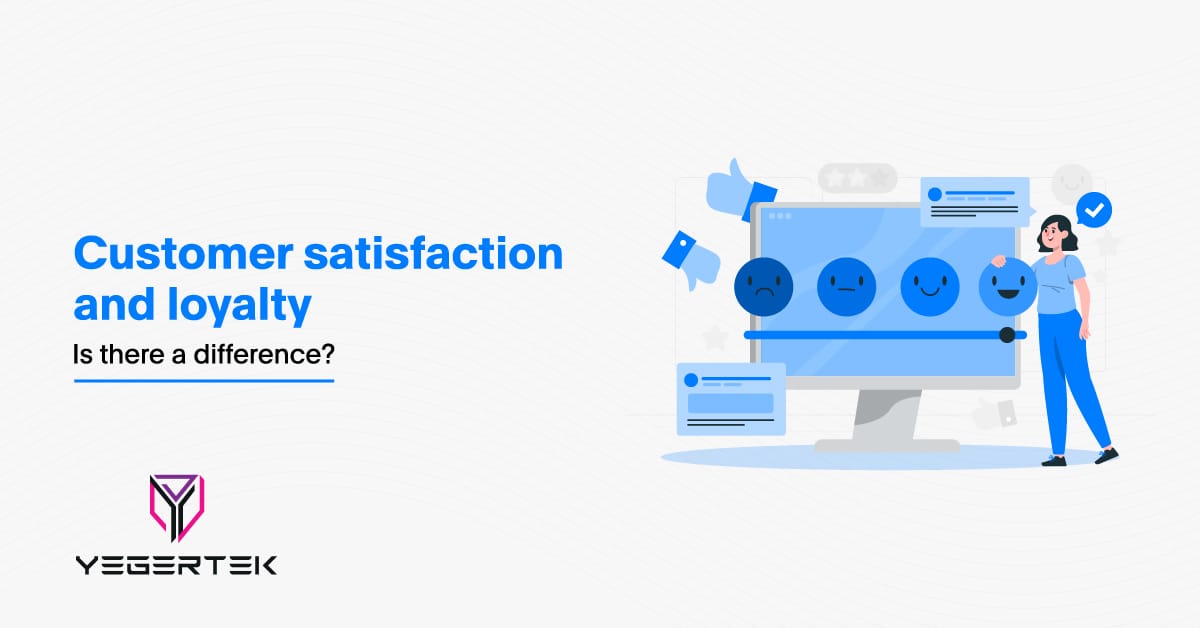
When we talk about customer loyalty, it is easy to assume that a satisfied and happy customer should also be loyal. After all, what else could be the driver of customer loyalty if not their satisfaction? Well, not really. Not every happy customer is likely to come back for another purchase. I may really enjoy the experience of shopping on one of those trending ecomm sites selling graphic t-shirts, but would I come back and buy more, without getting any discounts or rewards?
Not really!
While satisfaction and loyalty go hand-in-hand, they are not the same. One might say that satisfaction is a prerequisite for loyalty, but that would only be part of the picture. In this blog we will try to understand the differences between satisfaction and loyalty, and how you can utilize both to drive long-term growth. So let’s unpack it for you.
What is Customer Satisfaction and Customer Loyalty?
Customer satisfaction as the term suggests is a measure of how well your services or products are received by your customers. Satisfaction is what keeps the doors open for returning customers. It is immediate and transactional and helps answer questions like if the service was fast, if the product met your expectations, or if the website was easy to navigate, and so on.
Customer loyalty on the other hand is way more than a single experience. It delves into creating a lasting relationship between you and your customers based on a shared value system or mutual benefit. So what turns a satisfied customer into a loyal repeat customer? Emotional Connection! The key to driving customer satisfaction to the stage of loyalty is the sense of trust that you build with your customers in the short duration that they spend with your brand. If they believe that you understand their requirements and are genuinely invested in making it about them, they will come back for sure.
So to put it in simple terms, loyalty is the cumulative effect of multiple experiences over time. A connection that keeps people coming back even if the competitor offers a more tempting reward.
(Also Read: Top 11 Customer Loyalty Metrics You Should Track for Business Growth )
How Different Is Customer Loyalty from Satisfaction
As business owners, it is crucial to understand one thing, “while satisfaction can exist without loyalty, true loyalty rarely exists without satisfaction.”
To understand the difference between loyalty and satisfaction, we need to first understand the different behaviors tied to loyalty. Businesses that solely rely on customer satisfaction surveys to gauge their success, risk a false sense of security. Your customers might be satisfied with your products or services today, but that doesn’t necessarily mean that they would feel the same if a competitor offered a better deal.
Therefore, we have divided the customer behavioral metrics into different categories, to better understand how they impact customer loyalty –
Emotional Connectivity vs. Transactional
One of the differences between customer satisfaction and customer brand loyalty is that satisfaction is all about short-term interactions, mainly focusing on the transactional side of it. If you meet the immediate needs of your customers, chances are they will be happy.
Customer loyalty on the other hand is all about the emotional connection that you build with your customers, which makes brand loyalty a long-term commitment. It is all about going beyond transactional interactions and building a deeper bond with your customers based on shared values and appreciation. If customer satisfaction is a handshake, loyalty is a hug.
Difference in Customer Behaviour
Customer behavior could perhaps be considered as one of the biggest differences between customer loyalty and customer satisfaction. While customers may feel satisfied and happy at the moment, this happiness could be short-lived and may not necessarily result in repeat purchases. They may still turn their back on you if they feel they are better rewarded or find a better price from a competitor.
Loyalty goes a long way, with customers going out of their way to stick with you. Brand loyalty stems from the deep commitment that the customer shows to your business, sticking with you even when the competitor offers enticing products and better deals. This behavior stems from the trust that the customers have in your brand and their belief in your value. Loyal customers often do the job of ambassadors for your brand, bringing in more customers by spreading positive word of mouth.
Loyalty & Satisfaction Metrics
Evaluating different metrics that measure customer loyalty and customer satisfaction also helps greatly in understanding the difference between the two. Customer satisfaction can be easily tracked using tools such as CSAT (customer satisfaction score) and NPS (net promoter score). These metrics measure immediate levels of satisfaction and the willingness to recommend your brand, giving you a loose idea of how people feel about your brand.
Now unlike customer satisfaction, loyalty is more action-oriented. One of the very simple metrics to gauge customer loyalty is through repeat purchases. Another one is referral rate – where customers actively promote your brands to others, bringing in more clients), and CLV (customer lifetime value), which predicts the total revenue from a customer over the course of their relationship with your brand.
Satisfaction metrics give an idea of how your brand is doing currently, however, customer loyalty metrics reveal the real strength of your brand and customer relationships.
Moving from Satisfaction to Loyalty
Some businesses may see customer satisfaction as the foundation for loyalty, however, it’s not always guaranteed that a happy customer will also turn into a loyal one. You may instead consider satisfaction as a prerequisite to customer loyalty. For instance, if a buyer is not satisfied with their purchase, there is little to no chance that they will return. However, it doesn’t necessarily mean that if a client is satisfied, they will automatically become a loyal customer.
The journey of turning a happy client into a loyal one involves building deeper connections with your customers through shared values, rewards, and a brand voice that resonates with the sentiments of the customers. While satisfaction is the starting point of any customer’s journey towards becoming loyal buyers, without meaningful and repeated interactions, satisfaction holds no real value other than momentary benefit.
A buyer who is happy with their purchase may walk away the moment they find a better deal, a better option, or even something new and shiny. The real change takes place when you go beyond serving the customers’ materialistic needs to catering to their emotional needs, by making them feel valued and part of something bigger. A lot of factors play a key role in this, such as –
– Personalization
When businesses treat customers like individuals and not account numbers, people feel valued and respond to it through their loyalty. Tailored recommendations, personalized messages, and thoughtful follow-ups build trust and increase the likelihood of repeat engagement.
– Consistency
Another factor that determines whether your happy client would come back for another purchase is consistent and positive interactions. This helps businesses in creating a strong emotional bond with their clients, turning once-satisfied buyers into loyal customers. While satisfaction can be achieved in a single interaction, loyalty takes time and effort.
– Brand Values
Customers today are more likely to support purpose-driven businesses, especially people of the later generations like millennials and Gen Z. Modern customers look for businesses whose brand values align with their own, such as sustainability initiatives, diversity, inclusivity, ethics, etc.
Turning satisfied customers into loyal advocates for your brand requires building trust, delivering value consistently, and making people feel rewarded for their purchases, which is a long-term commitment.
Final Thoughts
So to bring it all together, there is no denying that satisfaction and loyalty are both essential for a successful business. However, they both serve different roles in your customer strategy. While customer satisfaction prevents customers from leaving, loyalty keeps them coming back (and bringing others with them).
As explored in this article, customer satisfaction and loyalty are interconnected yet separate concepts. While you do need satisfaction to earn customers, earning loyalty takes way more than just meeting expectations. The journey from happy customers to loyal advocates requires creating emotional connections, delivering consistent value, and proving you’re worth sticking with over the long haul.
So take your time to evaluate your current approach, the needs of your customers, and the value they seek from your business, and work on it. The end goal is to earn priceless customers who aren’t just happy but also loyal to your brand.



